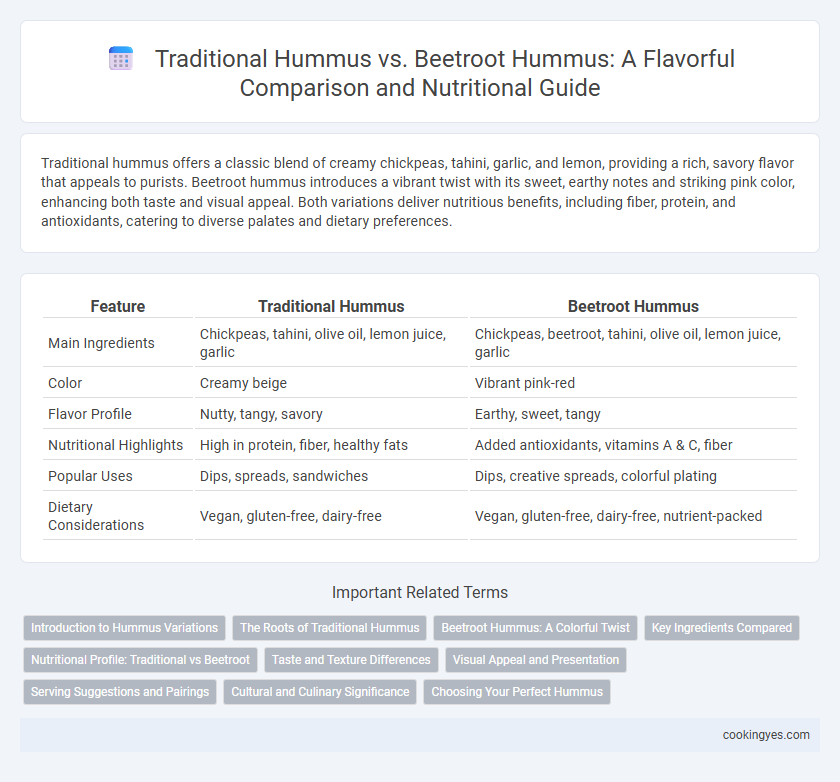Traditional hummus offers a classic blend of creamy chickpeas, tahini, garlic, and lemon, providing a rich, savory flavor that appeals to purists. Beetroot hummus introduces a vibrant twist with its sweet, earthy notes and striking pink color, enhancing both taste and visual appeal. Both variations deliver nutritious benefits, including fiber, protein, and antioxidants, catering to diverse palates and dietary preferences.
Table of Comparison
| Feature | Traditional Hummus | Beetroot Hummus |
|---|---|---|
| Main Ingredients | Chickpeas, tahini, olive oil, lemon juice, garlic | Chickpeas, beetroot, tahini, olive oil, lemon juice, garlic |
| Color | Creamy beige | Vibrant pink-red |
| Flavor Profile | Nutty, tangy, savory | Earthy, sweet, tangy |
| Nutritional Highlights | High in protein, fiber, healthy fats | Added antioxidants, vitamins A & C, fiber |
| Popular Uses | Dips, spreads, sandwiches | Dips, creative spreads, colorful plating |
| Dietary Considerations | Vegan, gluten-free, dairy-free | Vegan, gluten-free, dairy-free, nutrient-packed |
Introduction to Hummus Variations
Traditional hummus is a creamy blend of chickpeas, tahini, olive oil, lemon juice, and garlic, celebrated for its rich, nutty flavor and smooth texture. Beetroot hummus offers a vibrant twist, infusing the classic recipe with earthy sweetness and a striking magenta hue, which enhances both visual appeal and nutritional value through added antioxidants and fiber. These variations demonstrate the versatility of hummus as a nutritious dip adaptable to diverse taste preferences and dietary needs.
The Roots of Traditional Hummus
Traditional hummus roots trace back to ancient Middle Eastern cuisine, featuring a blend of chickpeas, tahini, lemon, and garlic that balances creamy texture with earthy flavors. The beetroot variation introduces vibrant color and a naturally sweet, earthy twist while maintaining the core chickpea base, offering a modern, nutrient-rich alternative. Both versions emphasize the foundational legume's nutrition, with traditional hummus rich in protein and fiber, and beetroot hummus adding antioxidants and vitamins like folate and vitamin C.
Beetroot Hummus: A Colorful Twist
Beetroot hummus offers a vibrant alternative to traditional chickpea-based recipes, incorporating roasted beets to deliver a naturally sweet, earthy flavor and striking deep pink color. Rich in antioxidants, dietary fiber, and essential vitamins like folate and vitamin C, beetroot enhances the nutritional profile compared to classic hummus. This colorful variation not only elevates visual appeal but also provides a unique taste experience ideal for health-conscious consumers and culinary innovators.
Key Ingredients Compared
Traditional hummus primarily combines cooked chickpeas, tahini, garlic, lemon juice, and olive oil, creating a creamy texture with a nutty and tangy flavor profile. Beetroot hummus incorporates roasted or boiled beetroot alongside the classic ingredients, introducing a vibrant color and a sweet, earthy taste that complements the nuttiness of tahini. The key difference lies in beetroot's natural sugars and betalains, which provide nutritional benefits such as antioxidants, contrasting with traditional chickpeas' higher protein and fiber content.
Nutritional Profile: Traditional vs Beetroot
Traditional hummus, made primarily with chickpeas, tahini, olive oil, lemon juice, and garlic, offers a rich source of plant-based protein, fiber, and healthy fats, along with essential nutrients like iron, folate, and manganese. Beetroot hummus variation incorporates beets, significantly boosting antioxidant levels, folate, and vitamin C content while slightly reducing calories and fat compared to traditional hummus. The addition of beetroot enhances the nutritional profile by providing betalains, compounds with anti-inflammatory and detoxifying properties, making beetroot hummus a vibrant, nutrient-dense alternative.
Taste and Texture Differences
Traditional hummus offers a creamy, nutty flavor with a smooth and slightly coarse texture derived from blended chickpeas and tahini. Beetroot hummus introduces an earthy sweetness and vibrant color, while maintaining a softer, creamier texture due to the moisture content of beetroots. The textural contrast is marked by beetroot hummus' moist smoothness versus the denser, grainier bite of traditional hummus.
Visual Appeal and Presentation
Beetroot hummus stands out with its vibrant magenta color, offering a striking visual contrast compared to the creamy beige of traditional hummus. This colorful variation enhances presentation by adding a bold, eye-catching element to platters and serving dishes. The vivid hue of beetroot hummus makes it a popular choice for creating visually appealing appetizers and enhancing table aesthetics.
Serving Suggestions and Pairings
Traditional hummus, made from chickpeas, tahini, lemon juice, and garlic, pairs exceptionally well with warm pita bread, fresh vegetables like cucumber and carrot sticks, and grilled meats for a classic Middle Eastern experience. Beetroot hummus, with its vibrant color and earthy sweetness, complements roasted vegetables, goat cheese, and crusty artisan bread, adding a visually striking and nutritious twist to appetizers or charcuterie boards. Both variations can be enhanced with olive oil drizzles and garnished with fresh herbs such as parsley or mint to elevate their flavor profiles and presentation.
Cultural and Culinary Significance
Traditional hummus, with its roots in Middle Eastern cuisine, showcases a rich cultural heritage through its use of chickpeas, tahini, garlic, and lemon, reflecting centuries-old culinary practices and regional flavors. Beetroot hummus variation introduces a vibrant color and earthy sweetness, symbolizing modern culinary innovation while honoring the dish's foundational elements. This fusion highlights the dynamic evolution of hummus, blending tradition with contemporary tastes in global gastronomy.
Choosing Your Perfect Hummus
Traditional hummus features a creamy blend of chickpeas, tahini, olive oil, lemon juice, and garlic, offering a classic, nutty flavor perfect for a wide range of dishes. Beetroot hummus introduces a vibrant color and earthy sweetness, enriched with antioxidants and vitamins, appealing to those seeking a nutrient-packed twist. Selecting between traditional and beetroot hummus depends on flavor preference and nutritional goals, with traditional providing a familiar taste and beetroot offering a visually striking and health-enhanced alternative.
Traditional vs Beetroot for hummus variation Infographic

 cookingyes.com
cookingyes.com